San Diego County, California
Sphingidae Adults
Manduca sexta, July 17, 2005, National City, San Diego County, courtesy of Douglas Aguillard.
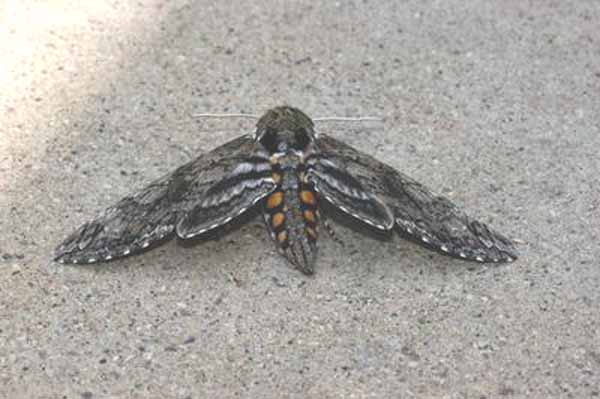
Manduca sexta, July 17, 2005, National City, San Diego County, courtesy of Douglas Aguillard.
It is hoped that this checklist, with the thumbnails and notes, will help you quickly identify the moths you have encountered.
A WO" after the species name indicates that I have no confirmed reports of these species in San Diego County, but I (William Oehlke) expect that these moths (Sphinx chersis [now confirmed by Steve Alexander, June 10, 2015], Eumorpha fasciata (as a stray) and Proserpinus clarkiae may be present.
A USGS indicates the moth is reported on the USGS website and/or in Moths of Western North America, #2. Distribution of Sphingidae of Western North America, revised, an excellent little booklet available through Paul Opler.
This page is inspired by and dedicated to Doug Aguillard. Doug sent me the image of the
Manduca sexta adult at the top of the page. The larva feed on tomato foliage, and can probably be found on garden tomatoes within its range.
A special thanks also goes to Don Doerfler for the following image of Smerinthus saliceti.
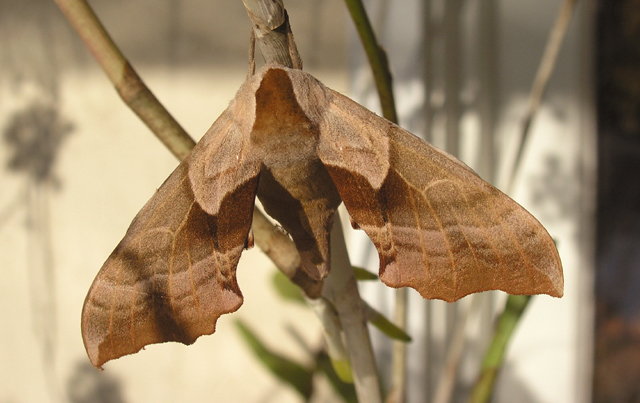
Smerinthus saliceti male, Encinitas, northern/coastal San Diego County, California,
August 21, 2007, 5:00pm, courtesy of Don Doerfler, Digital Camera: Olympus 5060, 8MP
Please help me develop this list with improved, documented accuracy by sending sightings (species, date, location), preferably with an image, via email to Bill Oehlke.
Chris Conlan writes from southern California: "Just thought I would report something rather interesting. I found several larvae of Cocytius antaeus feeding on the cherimoya trees in my backyard and in the yard of a friend who lives about 15 miles west of me. I also had reports of them from another friend last summer who lives several miles to the south but was never able to confirm with actual specimens. Looks like this species may be extending its range into southern California since many folks have backyard cherimoya trees. It also appears they are not really attracted to light as I run a MV light on my back deck most nights of the year and I have gotten many Mexican strays but never seen a Cocytius here until I found those larvae."
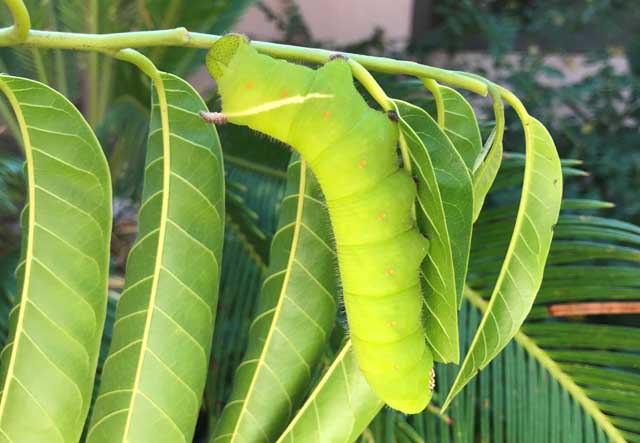
Cocytius antaeus final instar, Escondido, San Diego County, California,
on cherimoya, 2018, courtesy of Chris Conlan.
Manduca quinquemaculatus ... common, March, April, July
M, sexta ...ommon, June, July, August
Erinnyis obscura ... (2), May 20, April 24
Erinnyis oenotrus ...(1), September 11
Erinnyis ello ... (1), August 31
Proserpinus lucidus ... (1) March 4
Pachysphinx occidentalis ... (2) May 17, September 1
Smerinthus ophthalmica or cerisyi ... (4) August 19, 21, April 12, June 25
Eumorpha achemon ... (1) May 23
Hyles lineata ... common, March - May
Sphinx perelegans ... common, March 20, 28, July 17, August 24
All specimens taken at MV or UV lights on my porch at 1130 San Vicente View, Ramona, San Diego county, Ca. Elev, 1600 feet. Dates are all this year, 2014.
On June 10, 2015 Steve sent me the following data:
Agrius cingulata, (1), June 8, 2015
Sphinx chersis, (1), June 8, 2015
Manduca rustica, (2) Dec 2, 2014 & Jun 9, 2015
Visit San Diego County Sphingidae Larvae: Caterpillars; Hornworms
Visit California Catocala: Underwing Moths
If you are travelling, you can find active Sphingidae checklists for all countries in North, Central, and South America and the Caribbbean via the links at
North, Central, South American Sphingidae checklists
Sphinginae subfamily
Manduca sexta, common, June, July, August, Ramona, Steve Alexander
Smerinthini Tribe:
Pachysphinx occidentalis, May 17, September 1, Ramona, Steve Alexander
Macroglossinae subfamilyDilophonotini Tribe:
Philampelini Tribe:
Macroglossini Tribe:
Hyles lineata, Coronado Beach, December 13, 2012, Dan Decaro via Nancy Jean Marshall. Hyles lineata, Ocean Beach, a block from the ocean, April 6, 2014, Victoria Pak. Hyles lineata, common, March - May, Ramona, Steve Alexander
Proserpinus lucidus, (1) March 4, Ramona, Steve Alexander |
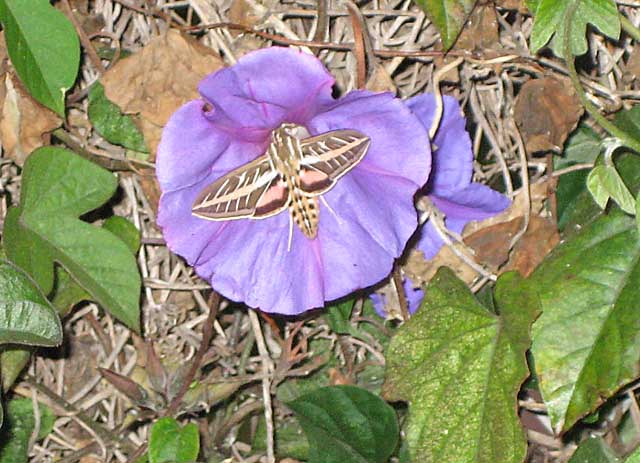
Hyles lineata, April 14, 2008, Imperial Beach, courtesy of Larry Trame.
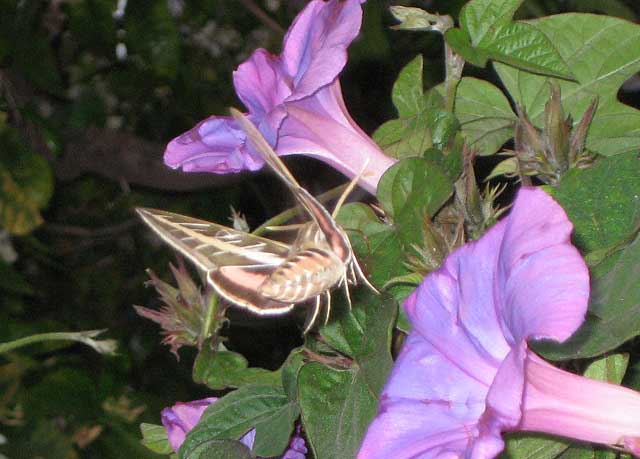
Hyles lineata, May 18, 2008, Imperial Beach, courtesy of Larry Trame.
"Thanks for looking at these!"
I was surprised to receive the following mid December image, taken by Dan Decaro, from Nancy Jean Marshall, but lineata probably broods continuously as long as the weather is warm enough.
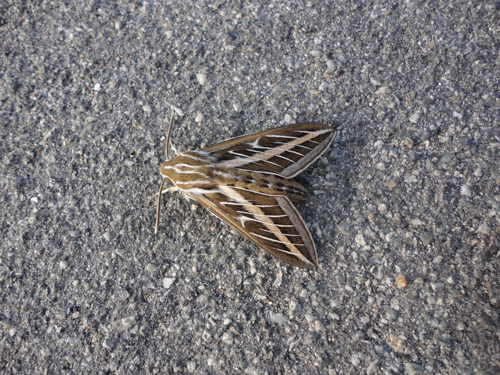
Hyles lineata, Coronado Beach, December 13, 2012,
courtesy of Dan Decaro via Nancy Jean Marshall.
Enjoy some of nature's wonderments, giant silk moth cocoons. These cocoons are for sale winter and fall. Beautiful Saturniidae moths will emerge the following spring and summer. Read Actias luna rearing article. Additional online help available.
Use your browser "Back" button to return to the previous page.
This page is brought to you by Bill Oehlke and the WLSS. Pages are on space rented from Bizland. If you would like to become a "Patron of the Sphingidae Site", contact Bill.
Please send sightings/images to Bill. I will do my best to respond to requests for identification help.
 Show appreciation for this site by clicking on flashing butterfly to the left. The link will take you to a page with links to many insect sites. |